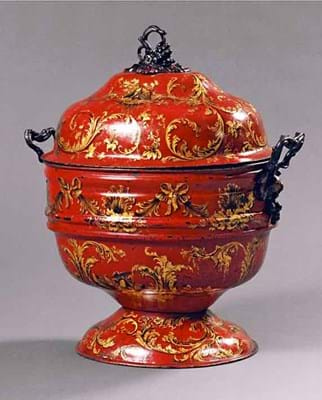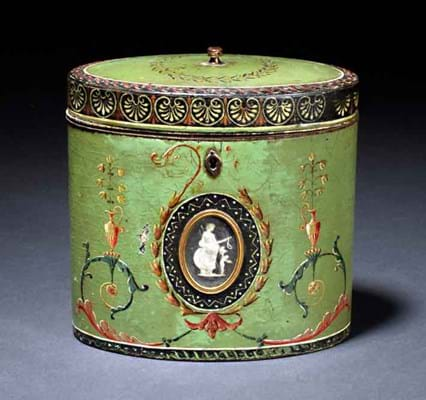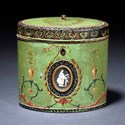The eventual result is Japanned Papier Mâché and Tinware, c.1740-1940, a substantial book of her own which sets out to dispel some of the myths.
One of her major conclusions is that japanning (multiple layers of varnish, baked between each application to create a characteristic smooth finish) was carried out in a large number of Midlands workshops. Many items are unmarked but it is a mistake, she says, to assume that all the good early wares were by Henry Clay and the later ones by Jennens and Bettridge.
At the same time she has concluded that tinware and papier mâché were often decorated in the same workshops and by the same craftsmen, who did not appear to regard tinplate as an inferior product.
The high quality of the workmanship found on both tinplate and papier mâché, and on marked and unmarked pieces, is demonstrated by an impressive range of illustrations drawn from auction catalogues as well as museums and private collections.
Nearly 40 Birmingham japanners are documented, many in great detail, and another 30 from Wolverhampton and Bilston, while further chapters cover London and Oxford factories, as well as products from other countries which might be confused with British wares. A separate directory lists nearly 100 known artists and decorators.
Definitive attributions may not always be possible but cataloguers now have an impressive volume of new information to draw on when describing anything from a simple tea tray to those suites of papier mâché furniture which remain as impressive today as when they dazzled visitors at the great international exhibitions of the 19th century.
- Japanned Papier Mâché and Tinware, c.1740-1940 by Yvonne Jones, Antiques Collectors' Club, 335pp, £45. ISBN: 9781851496860.
Tea Caddy
Yvonne Jones' research into japanning will doubtless greatly enhance the knowledge and value of examples of the genre for collectors and cataloguers, but meanwhile, there is already plenty of evidence in the market that good, historic, stylish pieces of japanned ware have a keen following.
The latest was the piece which came up in a sale of English Furniture and Works of Art held at Bonhams in London's New Bond Streeton March 6.
The 4½in (11.5cm) wide tea caddy is the epitome of neoclassical elegance with its Etruscan-style decoration of anthemions, scrolls and husks in a Pompeian palette of black, red, ochre and dark green on a pale green ground, especially with the addition of Wedgwood jasperware medallions inset to the front and back. In the 1770s, when this piece is thought to have been produced, it would have been the height of fashion on a tea table in polite society.
On stylistic grounds the caddy has been attributed to Henry Clay, the Birmingham contemporary of Matthew Boulton, who perfected the art of japanning objects and small furnishings and went on to set up a workshop in Covent Garden. It was in Clay's Birmingham days that he is thought to have developed the idea of setting Wedgwood's neoclassical medallions into his pieces.
This caddy was estimated at a reasonable £3000-5000 but it ended up selling for £8500.
The buyer's premium was 25/20/12%.








